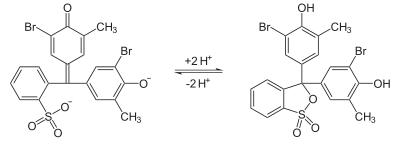溴甲酚紫
外观
| 溴甲酚紫 | |
|---|---|

| |

| |
| IUPAC名 3,3-Bis(3-bromo-4-hydroxy-5-methylphenyl)-2,1λ6-benzoxathiole-1,1(3H)-dione | |
| 别名 | 溴甲酚红紫、5,5′-二溴邻甲酚磺酰酞、5,5′-二溴邻甲酚红 |
| 识别 | |
| CAS号 | 115-40-2 |
| PubChem | 8273 |
| ChemSpider | 7974 |
| SMILES |
|
| InChI |
|
| InChIKey | ABIUHPWEYMSGSR-UHFFFAOYAH |
| ChEBI | 86154 |
| 性质 | |
| 化学式 | C21H16Br2O5S |
| 摩尔质量 | 540.22 g·mol−1 |
| 外观 | Purple powder |
| 熔点 | 241 - 242 °C(272 K) |
| 溶解性(水) | < 0.1 % |
| 危险性 | |
GHS危险性符号
| |
| GHS提示词 | Warning |
| H-术语 | H315, H319, H335 |
| P-术语 | P261, P264, P271, P280, P302+352, P304+340, P305+351+338, P312, P321, P332+313, P337+313, P362, P403+233, P405 |
| NFPA 704 | |
| 若非注明,所有数据均出自标准状态(25 ℃,100 kPa)下。 | |
溴甲酚紫(英語:Bromocresol purple、BCP)学名:5,5′-二溴邻甲酚磺酰酞 (英語:5′,5″-dibromo-o-cresolsulfophthalein),是一种三苯甲烷类染料和pH指示剂,在pH < 5.2时为黄色,在pH > 5.2为紫色。其分子结构具有磺酸内酯结构,且具有酸性,酸解离常数pKa = 6.3,常配成0.04%的水溶液使用[1]。
用途
[编辑]
| 溴甲酚紫(酸碱指示剂) | ||
| 低於pH 5.2 时 | 高於pH 6.8 时 | |
| 5.2 | ⇌ | 6.8 |
溴甲酚紫在医学实验室中常用于测定白蛋白,且比传统的溴甲酚绿效果要好[2][3]。
在微生物学中,常用于辨别活细胞和死细胞,因为两者的酸碱度不同,可用溴甲酚紫进行区分。同时也可以检测乳酸杆菌[4][5]。
在底片冲洗中,溴甲酚紫被添加到停影液中,用于停影浴(显影后定影前的酸性浴)中指示酸已经耗尽需要更换停影液[6]。
在溴甲酚紫添加在琼脂培养基中时,称为溴紫琼脂培养基,可用于区分微生物种类。如溴紫乳固体葡萄糖琼脂培养基可在牛和其他动物感染皮癣菌时区分疣状毛癣菌(T. verrucosum)与其他微生物[7][8]。
pH指示剂变色原理
[编辑]与溴甲酚绿变色类似,溴甲酚紫存在醌式和内酯式两种颜色不同结构的平衡反应,pH改变时导致平衡反应发生移动,呈现出颜色变化。在碱性和中性条件下,溴甲酚紫为磺酸基为磺酸根结构(醌式结构),显紫色,在酸性条件下,磺酸基变成磺酸内酯结构(内酯式结构),显黄色[9][10]。
合成
[编辑]由邻甲酚与邻磺基苯甲酸酐氯化锌作用110-120℃下缩合制成邻甲酚红,将得到的邻甲酚红溶于冰醋酸中,在40~50℃下通入溴进行反应,即可得到溴甲酚紫[11]。
相关条目
[编辑]参考文献
[编辑]- ^ Bromocresol Purple. NCBI PubChem. National Center for Biotechnology Information. [2024-07-06]. (原始内容存档于2012-10-04).
- ^ Bachmann, Lorin M.; Yu, Min; Boyd, James C.; Bruns, David E.; Miller, W. Greg. State of Harmonization of 24 Serum Albumin Measurement Procedures and Implications for Medical Decisions. Clinical Chemistry. 2017-03-01, 63 (3): 770–779. ISSN 0009-9147. PMID 28073902. doi:10.1373/clinchem.2016.262899
 (英语).
(英语).
- ^ Ito, Shigenori; Yamamoto, Daisuke. Mechanism for the color change in bromocresol purple bound to human serum albumin. Clinica Chimica Acta. 2010-02-02, 411 (3): 294–295. PMID 19932090. doi:10.1016/j.cca.2009.11.019.
- ^ Kurzweilová, H.; Sigler, K. Fluorescent staining with bromocresol purple: a rapid method for determining yeast cell dead count developed as an assay of killer toxin activity.. Yeast. November 1993, 9 (11): 1207–1211. PMID 7509098. S2CID 44782970. doi:10.1002/yea.320091107.
- ^ Lee, H.M.; Lee, Y. A differential medium for lactic acid-producing bacteria in a mixed culture. Letters in Applied Microbiology. June 2008, 46 (6): 676–681. PMID 18444977. doi:10.1111/j.1472-765X.2008.02371.x
 .
. 
- ^ Anchell, Steve. The Darkroom Cookbook 4. Routledge. 2016. ISBN 9781317337607 –通过Google Books.
- ^ Kane, J.; Summerbell, R.; Sigler, L.; Krajden, S.; Land, G. Laboratory Handbook of Dermatophytes: A Clinical Guide and Laboratory Handbook of Dermatophytes and Other Filamentous Fungi from Skin, Hair, and Nails. Belmont, CA: Star Publishing Company. 1997. ISBN 9780898631579.
- ^ Beneke, E. S.; Rogers, A. L. Medical Mycology and Human Mycoses illustrated. Belmont, CA: Star Publishing Company. 1996: 85–90. ISBN 9780898631753.
- ^ Bromocresol Purple - an overview | ScienceDirect Topics. [2024-07-06]. (原始内容存档于2024-07-06).
- ^ Archived copy. [2022-02-15]. (原始内容存档于2022-02-16).
- ^ 安家驹 (编). 实用精细化工辞典. 北京: 中国轻工业出版社. 2000: 1167.


